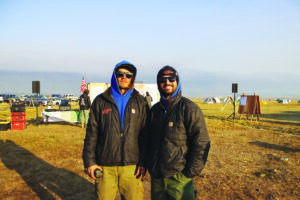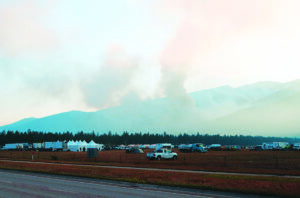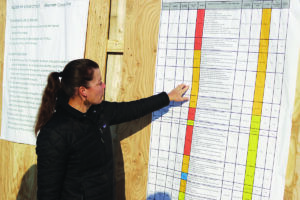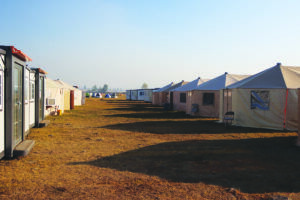
by John Dowd
As of Monday, the Sharrott Creek Fire had grown to over 2,399 acres and has over 610 people assigned to it, with more coming in. Many of these statistics are updated daily, in public reports anyone can access. What the public often doesn’t know about or see is what it takes to contain a fire, and the men and women between the public and the blaze.
Most fires see a couple types of crews that set out on foot. These include Type 1 Interagency Hotshot Crews (IHC) and Type 2 Initial Attack (IA) Crews. The Hotshot crews are considered the elite, with rigorous training and experience. Being a national resource, these men and women are utilized nationwide. However, the brunt of the force on the ground doing a lot of the work are the Type 2 folks. Both are considered “the backbone of fire suppression,” according to Jeni Garcin, a public information officer for the Sharrott Creek Fire.
Garcin said there are a lot of pieces that go into dealing with forest fires, and a lot of men and women that are gone from home for months, away from family and friends, to put their lives on the line to keep others safe. It can not only be taxing on the body, especially for these kinds of crews, but for family life, relationships and overall health. However, these people love what they do.

Connor Harrison and Henry Lathrop are forestry technicians with the National Forest Service. Though they are not technically referred to as firefighters, that is what they do. They are members of the 20-person Palouse Type 2 IA hand crew, out of Idaho. Their group was named after a notable landmark in Western Idaho and Eastern Washington, near Potlatch, Idaho, where they are based. In fact, most crews are named in the same way, taking a name from a close and prominent landmark. This helps keep track of which crew is which, as well as providing them with a moniker with more meaning to rally behind than just a number.
Their crew deploys together, and while Type 1 units are often immediately available nationwide, their Type 2 status is restricted to a U.S. Forest Service resource and they often stay in their region. They prioritize the local forest first, then they can be available to the rest of the nation.
Harrison and Lathrop are seasonal, working for six to seven months out of the year, then taking the rest off. They spoke at length about their time as firefighters for the Forest Service and talked about what it is really like to work in the heat.
Harrison has been a forestry technician for three years, and Lathrop for four. As members of the same crew, they often eat, sleep, deploy and experience fires together, with their 20-person crew, for almost six months straight. It helps that they are a close knit group of friends, even outside of work. For them, that is an important part of the job, knowing that someone always has their back and that they are all in it together.
In the early months of the season, generally around April, they do mostly local work in their own area of the National Forest. When their season starts, it usually involves working together to get back into the swing of things and doing a lot of hiking, as well as PT, to keep in shape for the upcoming season. When the fires really kick off, they could be sent anywhere at any time. However, their crew stays mostly in Montana and Idaho, in the Forest Service’s Northern Rockies District.
Harrison and Lathrop spoke on how frustrating this can end up being. Where they are located, the men said sometimes they will see fires within driving distance, and it breaks their hearts not to be able to respond. These fires can be out of their district, and since they go where they are sent, sometimes it means letting somewhere burn or be dealt with by other crews, hopefully.
Their days are often long and unpredictable. “You never know what your day is going to look like,” said Lathrop. According to both men, there are a lot of variables, but always two constants: “It’s going to be steep and it’s going to be hot!” Their job is to get as close to the blaze as possible on foot and begin fire mitigation work, cutting lines, moving trees and creating systems to break fire activity. They do all kinds of work, from mop-up, to back burning and even rehabilitation for burned areas.
Palouse is deployed when the fire is on difficult, deep and steep terrain, where vehicles cannot get to. They carry everything they need with them, often hauling over 45 pounds of personal gear and then their heavy equipment, like chainsaws, fuel and hand tools. This means they are often going out with around 65 pounds of gear. Harrison is also an EMT for the group and brings with him extra first aid equipment and a trauma kit.
They will work for a standard 14 days straight, and only get a few hours off in between to recoup. The way their schedules work, they often do at least a year’s worth of work hours in six months.
“It’s not always action and intensity,” said Lathrop. Both men spoke on the down time, and how their job is often “zero to 100” in a very short amount of time. They always need to be ready.
“It’s a lot of holding, sitting there, waiting for something to happen,” said Harrison.
When they are on a fire, it’s all hands on deck, and they take long shifts, sometimes even 16 hours, going out night and day, to work on the blaze. In the short time they have off each day, they try to get in showers and sleep, which, according to Garcin, “Is never enough.”
For the forestry technicians, their season stretches from April to October. In their down time, they try to visit family and stay active. In his free time, Harrison said he has been base jumping (jumping from a fixed place with a parachute), and traveling the world.
The Palouse Crew is just one of 16 crews on the Sharrott Creek Fire, and each one goes through the same thing. There are a number of unique factors on each fire that they all have to deal with. According to Lathrop and Harrison, the most important and pressing issue with the Sharrott Creek Fire is the direct threat to several private homes on the mountain side. This is different from many of the fires they work on, which are often “semi remote.” With those extra dangers, “there’s that added pressure,” Lathrop added. He referred to the over 50 threatened private residences in immediate danger of this fire.
However, not everyone on fires works in the front lines or starts their career as a firefighter. Garcin is a public information officer for the Sharrott Creek Fire, and got her start with environmental quality with state and local governments in Montana. She moved into working fires in her current capacity after gaining experience in all-hazard and law enforcement incidents and taking advanced training. Her job is communication with the press and the public, as well as to relay information. She works under Mike Behrens, the incident commander for this fire.

Garcin is officially a part of Northern Rockies Complex Incident Management Team 3, one of five teams in the region. Her section is only one piece of the incident management team, which handles a lot of the logistics, organization and overall activities that make fire fighting happen. Many people that have never worked on forest fires may be surprised to learn how complex the networking can be, and all the pieces involved.
Garcin described the organization, explaining how different agencies all come together to fight these fires. These groups include sections that cover areas like safety, logistics, operations and even finance. All of these sections include members of various entities like the U.S. Forest Service, local and state law enforcement, emergency management agencies, and many more.
A lot of the management side comes down to assessing what resources can become available, depending on many factors. Much of it is threat assessment. With the Sharrott Creek Fire in particular, which grew very quickly in the first few hours due to the powerful wind event that coincided with its origin, there were numerous resources that became available relatively quickly, when compared to other fires.
Nationwide, fire fighting resources are limited. At the top, there are priority lists that determine which fires will most benefit from which resources and incident management teams have to update their situations daily. The reports they write determine their situational urgency and what they may need. The way they write those reports, the assets at risk, the urgency of the situation and amount of pressure across the country on resources will often determine what will become available to teams.
Fortunately, according to Garcin, the team working on the Sharrott Creek Fire is getting the resources it needs. “We still have a lot of firefighting to do, but there is a solid plan in place and we’re adjusting as needed,” said Garcin.

However, because of its visibility to the public, and the possibility of spreading to the private homes, the Sharrott fire is getting a lot of attention. According to Garcin, “We’ve had time to set up home protection measures while we work to gain containment,” which bodes well for the outcome.
According to Garcin, they have also started burning operations to back-burn sections around the fire to limit fuel for the fire to spread. This is meant to “create more depth to the lines so the fire can’t cross,” said Garcin.
With teams doing all they can, Garcin spoke on what the public can do to help. She brought up the confusion many people may have over how these fire teams work and how they should support the firefighters. The fire camp, and individuals outside the camp, often receive a lot of things from the public like water and food. Garcin wants to discourage this. The teams and assigned resources, coming from many different agencies and private contractors, have government backing and supplies which are strictly controlled, and include everything they need to function day to day. Being that they have plenty of supplies, “we are unable to accept much of what the public brings,” said Garcin.
Instead, Garcin suggested supporting local firefighters, year round. In most of Montana, many of these departments are volunteer, and need the support. She said these volunteers are important because they do not get paid and often fundraise for their own limited equipment. They are also usually the first ones on the scene in these kinds of fires.
“Speak to them, find out what they need, long term,” said Garcin. For the interagency fire crews and teams, Garcin said, “Moral boosters are often all they need. Thank you’s go a long way,” and signs posted in support of the firefighters are a huge reminder to fighters that their tireless work is appreciated. This will not only keep the public from interfering with operations, but will also go further than any supplies the community could ever donate.
